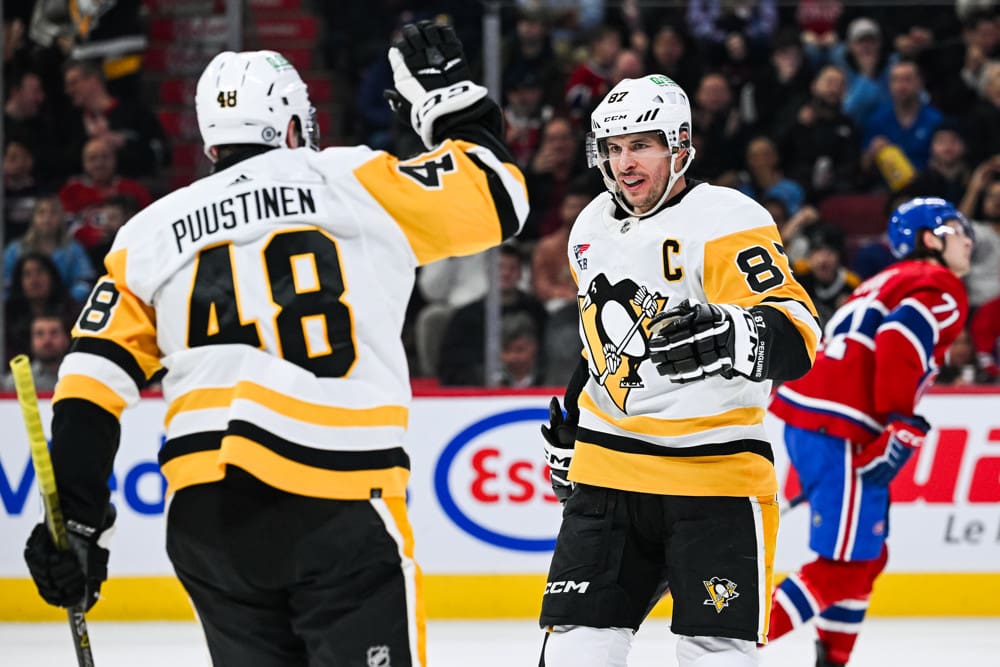Penguins
Penguins Blog: Puustinen Emerges; Can Dubas Pull Another Magic Trade?

It’s not often a win is polarizing amongst a fan base, but I felt that very vibe Monday night and Tuesday morning. The Pittsburgh Penguins beat the Minnesota Wild 4-3, controlled most of the game, but still punted a 3-0 lead with a handful of defensive gaffes. A new figure has emerged who might be central to the Penguins’ story this season, and a sneaking suspicion the Penguins could be a major player on the NHL trade market.
The little winger who is developing a big game. He has four assists in five games this season and has earned his keep. The biggest question is sustainability. Can Puustinen maintain the level of play?
First, I think that’s an easy yes. He doesn’t seem to be playing on adrenaline, as Radim Zohorna did, but a good combination of street smarts, ability, and “want-to.”
He’s a bit feisty. If you isolate your focus on just him, you’ll see him scrap along the wall or go to the net, in addition to making smart plays with the puck.
Puustinen’s defensive game is shaky. There’s no reason to gloss over it, but there’s also no reason to believe he’s not improving or disinterested in improving. His defensive awareness might provide a couple of headaches, but at least it’s not due to a lack of commitment.
He looks just like his dad, who wears original Air Jordans (or recent re-releases). That’s not anything important, but it fits with the amusing player who likes to laugh and forever has a smile on his face in the locker room. He’s a good kid.
“I’m feeling — day to day is better. Yeah. It’s like I’m here (but) my English isn’t the best, but the guys don’t care,” Puustinen said. “They talk to me. It’s funny if I don’t ask in perfect English.”
For comparison’s sake, let’s say his floor is Dominik Simon, and his ceiling might be a bit above Conor Sheary (before the slump that chased him out of Pittsburgh). It’s hard not to like what you’re seeing.
Don’t hold me to this now, but he seems like a solid 40-point winger. A few goals would be nice, but he seems to be at the beginning of his runway, not the end. He’s getting better, not plateauing.
“He’s an eager, enthusiastic learner. And so he’s going to get better with every game … He’s a smart player. He has an aptitude for the game, you can see it in the decisions he makes with the puck,” Sullivan said Monday night. “He’s a smart player … And so the mistakes that he does make are usually mistakes of enthusiasm because he’s trying to win a puck battle or whatever it may be. I think he’s got a lot of aptitude for the game, and I think he’ll get better with every experience that he goes through … I think his energy and, quite frankly, just his overall performance has been really good for us.”
What is Penguins’ Hockey?
I thought Sullivan veered into an illuminating answer Monday night about his direction and reasoning for the Penguins system. I’ve wondered aloud why the team doesn’t more often adopt their 1-2-2 structure neutral zone counter that was successful against several teams, including the Colorado Avalanche and Anaheim.
‘I think when our team is at its best, we play smart hockey, not reckless hockey, but not safe hockey either. And I think there’s a difference. And we’re trying to find out what that looks like,” Sullivan said Monday morning. “So I think there’s an inherent risk in playing a cautious game if we just let teams come at us. That’s not a recipe for success. We would phrase that as a game, as safe hockey, cautious hockey. I don’t think that’s the game that we want to play. We also don’t want to play a reckless game because that just doesn’t give us the best chance to win. We want to play smart. And that’s what we’re looking for.”
Emphasis added by PHN.
In fairness, the Penguins seemed to drop to the 1-2-2 against Arizona last week but were blitzed in the third period, allowing easy, controlled zone access and sustained pressure.
Somewhere in the middle is the Penguins’ best game.
Penguins Trade Targets
There are no whispers, first or second-hand, connecting the Penguins to any of the big names on the NHL trade block. Yet it seems there are a few pending UFAs that could transition the Penguins from this phase to the post-core-three era while dramatically increasing the Penguins’ chances in the interim, too.
According to Elliotte Friedman of Sportsnet, Elias Lindholm of the Calgary Flames is likely the next big-name center to hit the market. The versatile center has scored 40 goals in the past but is solid defensively. His $4.85 million contract will expire after this season, and he figures to double his take.
His pending UFA status also means his trade value is lower.
We’ve long felt Penguins president of hockey operations/GM Kyle Dubas could reunite with one of his former core players from the Toronto Maple Leafs, as Toronto might be forced to part with one.
We’ll put Lindholm in that category. The Penguins’ salary cap structure could support an expensive player acquisition for next season. Next year will also be Evgeni Malkin’s third year of a four-year deal, presumably his last NHL contract.
Like Mario Lemieux before him, Malkin could easily make the transition to the wing, becoming an extraordinary threat with a little easier workload. Such a move could provide a replacement if the Penguins cannot or will not re-sign Jake Guentzel.
Another legitimate No. 1 center could also lessen the burden on Sidney Crosby, allowing him to punish second-defensive pairs and second-line centers.
One wonders if a retool might be necessitated if not desired from the top of the organization. One also wonders, based on Dubas’s sleight of hand in acquiring Erik Karlsson, if the Penguins might be the surprise acquirers of another prized possession.


